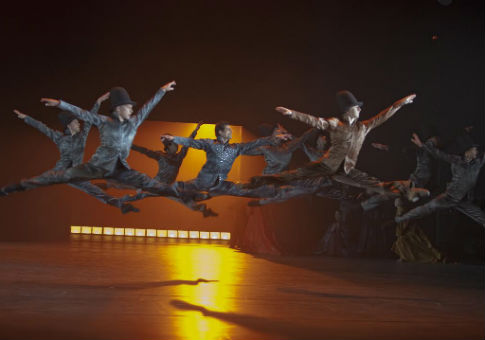I don’t think you can say you’ve seen a contemporary ballet until you’ve seen one where both Segways and jeans make their way onto the stage.
Mats Ek is broadly known for his imaginative—at times radical—adaptations of the classics. His focus is not on technique but on emotion and individual expression. Both of which were very much on display in Ek’s Juliet and Romeo, performed in its North American premier by the Royal Swedish Ballet at the Kennedy Center.
Ek started his theater training at Marieborg Folks College in Norrköping, Sweden. After this, he worked as a producer in two prominent Swedish theaters, the Royal Swedish Dramatic Theatre and the Marionettes Theatre in Stockholm. This background helped him join the Cullberg Ballet, named after his mother, Birgit Cullberg. There, he was a part of the corps de ballet. He worked with a number of prominent European ballets after this before moving back to Sweden to share, then ultimately take over, artistic leadership of the Cullberg Ballet in 1993. By then he had made a prominent name for himself in contemporary ballet.
Shakespeare’s main action and characters—star-crossed, suicidal teenage lovers, family enmity—make the cut in this production, but they are presented to the audience in an untraditional way, to say the least. Simplicity and modernization were emphasized in this production, from the set to the costumes to the movement of the dancers. The ballet at times seemed more of a theatre performance in its use of vocals—complete with yelling and laughing ballerinas.
Ema Yuasa danced a delightful, quirky Juliet. In one striking sequence, Juliet fought with her father, played by Andrey Leonovitch. Juliet repeated the same simple movements: a child throwing a tantrum. She seemed not to be in the fight to make a point. Rather she wanted her frustration to be felt by the people around her. Leonovitch, meanwhile, danced around his daughter with mature, calm, forceful movements.
Mercutio (Clyde Emmanuel Archer), known here as the Joker, was conceived by Ek as a ham—doing things that younger members in the audience found funny. He danced around in heeled shoes and a black tutu, playfully flipping off the other characters.
A notable departure from the ordinary was Ek’s use of Tchaikovsky’s music as opposed to the normal choice of Prokofiev. The two scores are different because Tchaikovsky’s doesn’t have an opus number—meaning there is no chronological order to his composition in reference to parts of the play. Tchaikovsky’s Fantasy-Overture is darker than Prokofiev’s, which fit perfectly with the dim, shadow-intensive lighting used throughout the performance.
Juliet and Romeo suffers somewhat in the dignity department, if you go in for that sort of thing. The dancers are shoeless, in jeans. The use of Segways was discordant, if interesting at times—in one scene, Juliet approaches a man on a Segway, eyeing him delicately. Enchanted, he slows down, breaking from the pack of other men. Then, in tune with the music, he slowly turns around and leaves the stage.
Ek’s sets showed his devotion to contemporary minimalism. They consisted of just three walls that were moved around from scene to scene by the corps de ballet. This seemingly foolproof concept came with its share of difficulties. In four instances, a wall caught on the floor, causing the dancers to stumble as they strained to move it in time. The dancers made due, though. Romeo (Anton Valdbauer) even navigated the set effortlessly.
The bottom line: the production was grating, jarring, and emotional. In other words, it was precisely what Ek wanted it to be.
